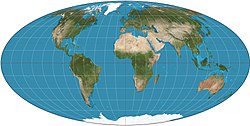Kuwaternaryo
| Kuwaternaryo | |
|---|---|
| 2.58 – 0 milyong taon ang nakakalipas | |
 Proheksiyong Mollweide ng kasalukuyang mundo | |
| Kronolohiya | |
| Etimolohiya | |
| Pormal | Formal |
| Impormasyon sa paggamit | |
| Celestial body | Earth |
| Paggamit panrehiyon | Global (ICS) |
| Ginamit na iskala ng panahon | ICS Time Scale |
| Kahulugan | |
| Yunit kronolohikal | Period |
| Yunit stratigrapiko | System |
| Pormal na time span | Formal |
| Kahulugan ng mababang hangganan |
|
| Lower boundary GSSP | Monte San Nicola Section, Gela, Sicily, Italy 37°08′49″N 14°12′13″E / 37.1469°N 14.2035°E |
| GSSP ratified | 2009 (as base of Quaternary and Pleistocene)[3] |
| Upper boundary definition | Present day |
| Upper boundary GSSP | N/A |
| GSSP ratified | N/A |
| Atmospheric at climatic data | |
| Mean atmospheric O2 content | c. 20.8 vol % (104 % of modern) |
| Mean atmospheric CO2 content | c. 250 ppm (1 times pre-industrial) |
| Mean surface temperature | c. 14 °C (0 °C above modern) |
Ang panahong Kwaternaryo (Espanyol: Cuaternario, Ingles: Quaternary) ang pinaka-kamakailan sa tatlong mga panahon ng era na Cenozoiko.[4] Ito ay sumusunod sa panahong Neoheno at sumasaklaw mula 2.588 ± 0.005 milyong taon ang nakalilipas hanggang sa kasalukuyan. Ang relatibong maikling panahong ito ay inilalarawan ng isang serye ng mga glasiasyon, ang paglitaw at paglaganap ng anatomikong modernong mga tao at ang patuloy na epekto ng mga ito sa natural na daigdig. Ang Kwaternaryo ay kinabibilangan ng dalawang mga epoch na heolohiko: ang Pleistocene at ang Holocene. Ang isa pang iminungkahi ngunit hindi pa pormal na epoch ang Anthropocene na nagkamit ng kredensiya bilang panahon na ang mga tao ay malalim na umapekto at nagbago ng kapaligirang pangdaigdig bagaman ang simulang petsa nito ay pinagtatalunan pa rin.
Mga sanggunian
- ↑ Cohen, K. M.; Finney, S. C.; Gibbard, P. L.; Fan, J.-X. (Enero 2020). "International Chronostratigraphic Chart" (PDF). International Commission on Stratigraphy. Nakuha noong 23 Pebrero 2020.
{cite web}: CS1 maint: date auto-translated (link) - ↑ Mike Walker; atbp. (Disyembre 2018). "Formal ratification of the subdivision of the Holocene Series/Epoch (Quaternary System/Period)" (PDF). Episodes. Subcommission on Quaternary Stratigraphy (SQS). 41 (4): 213–223. doi:10.18814/epiiugs/2018/018016. Nakuha noong 11 Nobyembre 2019.
{cite journal}: CS1 maint: date auto-translated (link) - ↑ Gibbard, Philip; Head, Martin (Setyembre 2010). "The newly-ratified definition of the Quaternary System/Period and redefinition of the Pleistocene Series/Epoch, and comparison of proposals advanced prior to formal ratification" (PDF). Episodes. 33 (3): 152–158. doi:10.18814/epiiugs/2010/v33i3/002. Nakuha noong 8 Disyembre 2020.
{cite journal}: CS1 maint: date auto-translated (link) - ↑ See the 2009 version of the ICS geologic time scale